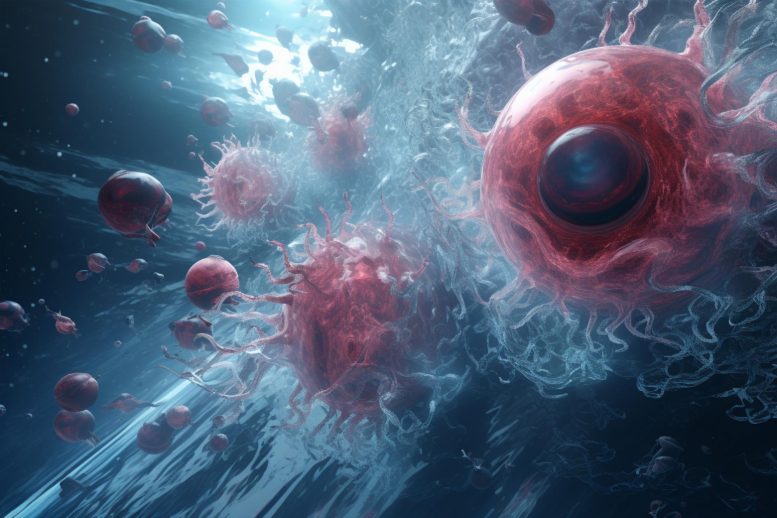
Digital simulation suggests a small percentage of pathogens could cause significant ecological damage.
According to a new study, ancient pathogens released from melting permafrost have the potential to damage microbial communities and potentially threaten human health. Through computer simulations, researchers found that these “time-traveling” pathogens often survive and evolve in modern environments, with some even causing significant alterations in host species. Despite their rarity, these pathogens could represent a substantial hazard due to the sheer volume of ancient microbes regularly released into contemporary communities.
Unearthing Ancient Pathogens
Ancient pathogens emerging from melting permafrost present a real possibility of damaging microbial communities, and might potentially pose a threat to human health. This is according to a new study published on July 27 in the open-access journal PLOS Computational Biology by Giovanni Strona of the European Commission Joint Research Centre and colleagues.
The concept of “time-traveling” pathogens, trapped in ice or secluded within remote laboratory facilities, breaking free to cause catastrophic outbreaks has been a popular theme for novelists and screenwriters for generations. While melting glaciers and permafrost are giving many types of dormant microbes the opportunity to re-emerge, the potential threats to human health and the environment posed by these microbes have been difficult to estimate.
Quantifying the Risks With Computer Simulations
In their innovative study, Strona’s team set out to quantify the ecological risks posed by these microbes using computer simulations. The researchers simulated scenarios of artificial evolution where digital virus-like pathogens from the past invade communities of bacteria-like hosts. They then compared the effects of these invading pathogens on the diversity of host bacteria against control communities, where no invasion took place.
The team discovered that in their simulations, the ancient invading pathogens often survived and evolved in the modern community, with about 3 percent becoming dominant. However, most of the dominant invaders had little impact on the larger community’s composition.
The Impact of Invading Pathogens
Approximately 1 percent of the invaders produced unpredictable results. Some of these invaders caused up to one-third of the host species to die out, while others increased diversity by up to 12 percent when compared to the control simulations.
While the risks posed by this 1 percent of released pathogens might seem minimal, considering the sheer number of ancient microbes regularly released into modern communities, outbreak events could still present a significant hazard. The new findings suggest that the risks posed by time-traveling pathogens – primarily confined to science fiction stories until now – could indeed become powerful drivers of ecological change and threats to human health.
For more on this study, see Unleashing “Time-Traveling” Pathogens From the Icy Past.
Reference: “Time-travelling pathogens and their risk to ecological communities” by Giovanni Strona, Corey J. A. Bradshaw, Pedro Cardoso, Nicholas J. Gotelli, Frédéric Guillaume, Federica Manca, Ville Mustonen and Luis Zaman, 27 July 2023, PLOS Computational Biology.
DOI: 10.1371/journal.pcbi.1011268
Funding: GS, PC, VM and LZ where partly supported by a “HiLIFE BIORESLIENCE seed grant” from the University of Helsinki. The funders had no role in study design, data collection and analysis, decision to publish, or preparation of the manuscript.
Never miss a breakthrough: Join the SciTechDaily newsletter.
2 Comments
Typically, pathogens and their hosts co-evolve in what is akin to an “arms race.” Most pathogens specialize in their host(s), and only infrequently cross the ‘species barrier.’ It isn’t impossible that frozen pathogens or parasites will be a danger to more modern species. However, it is probably unlikely that those that ‘missed the train’ and have been in stasis for ten’s of thousands of years are going to be a serious threat to those organisms that continued to evolve all that time. Potential hosts, that are more evolved, may well have had a previous exposure, and upon re-exposure to that past pathogen, activate a dormant gene for protection.
I don’t think that synthetic organisms evolved from John Conway’s game of Life are a good proxy for what happens in the real world. Does the simulation account for the presence of antibodies, or evolved defenses against predators with similar characteristics? As an example, the North American antelope is thought to have evolved its great speed and agility as a defense against a now extinct species of cheetah. If cloning brought back the North American cheetah, there is no reason to believe that today’s antelopes would be defenseless against their predation.
What if a pathogen goes after out food supply? All the corn dies, or other vegetables die. That could be bad too. Also what if an organism re-emerges, and just starts to multiply, and won’t stop altering everything. That could be bad too.